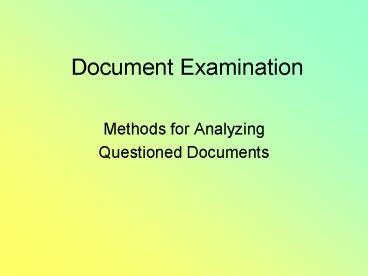Document Examination - PowerPoint PPT Presentation
1 / 9
Title:
Document Examination
Description:
Document Examination Methods for Analyzing Questioned Documents Macroscopic Techniques Reflected Light observation of a document under normal lighting. – PowerPoint PPT presentation
Number of Views:103
Avg rating:3.0/5.0
Title: Document Examination
1
Document Examination
- Methods for Analyzing
- Questioned Documents
2
Macroscopic Techniques
- Reflected Light observation of a document under
normal lighting. - May reveal incorrect paper, incorrect pen, or
format errors - Oblique-light (side light or grazing light)
- Reveals shadows from erasures, indentations, and
embossments - Transmitted light Use of a light box
- Identify type of paper and watermarks
- Detect erasures (thin spots in paper)
3
(No Transcript)
4
Microscopic Techniques
- Stereoscope with 10-30 power is most useful for
document examination - Determine type of pen used
- Detect retouching, pen lifts, tremor, erasures,
corrections
5
Spectral Techniques
- Ultraviolet light
- Fluorescence
- Detect erasures and corrections
- Enhance faint writing
- Dissimilar glues or wax tampering on envelopes
- Infrared light (viewed by special means)
- Detect undersketching in art
- Decipher charred documents
- Differentiate inks (some absorb, while others
reflect IR light)
6
(No Transcript)
7
(No Transcript)
8
- Laser techniques
- Discriminate between similar inks
- Photographic techniques
- UV, IR, and laser photography
- Chromatography (thin layer or paper)
- Ink from document is analyzed along with
reference (suspected) ink samples - Inks are placed on thin layer of silica gel (or
paper), which is then placed into a solvent. - The solvent moves up the gel or paper by
capillary action, separating inks as it moves.
9
- Chromatography is based on polarity. The gel or
paper has a different polarity than the solvent. - Parts of the ink that are more like the gel or
paper will not move, while those that are more
like the solvent will travel up the
chromatogram. - Samples that produce similar chromatograms are
likely to be the same ink.































